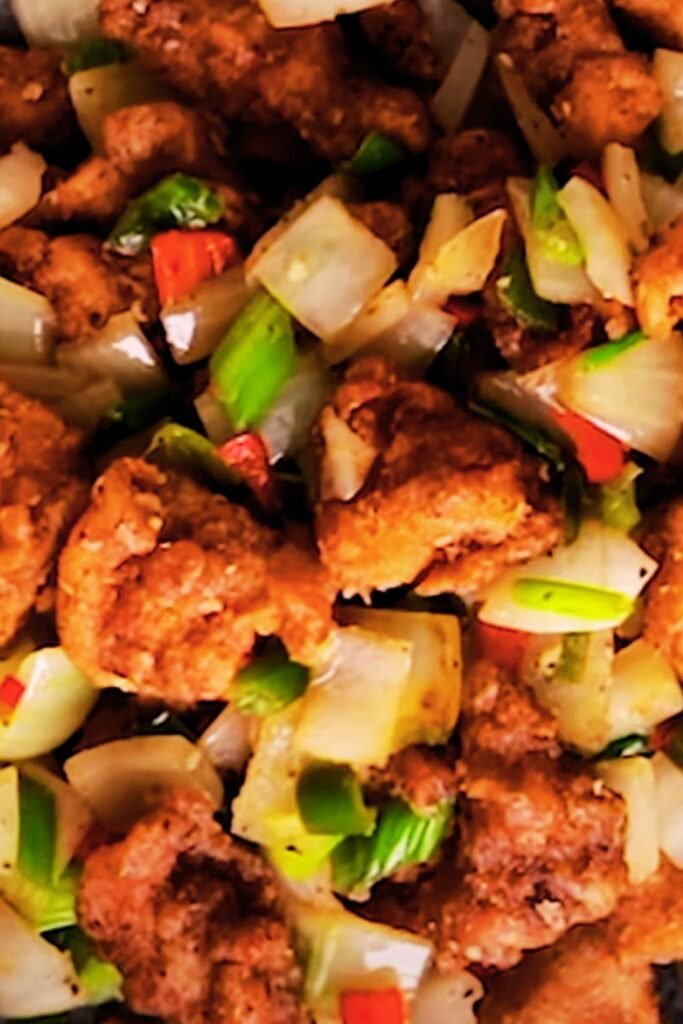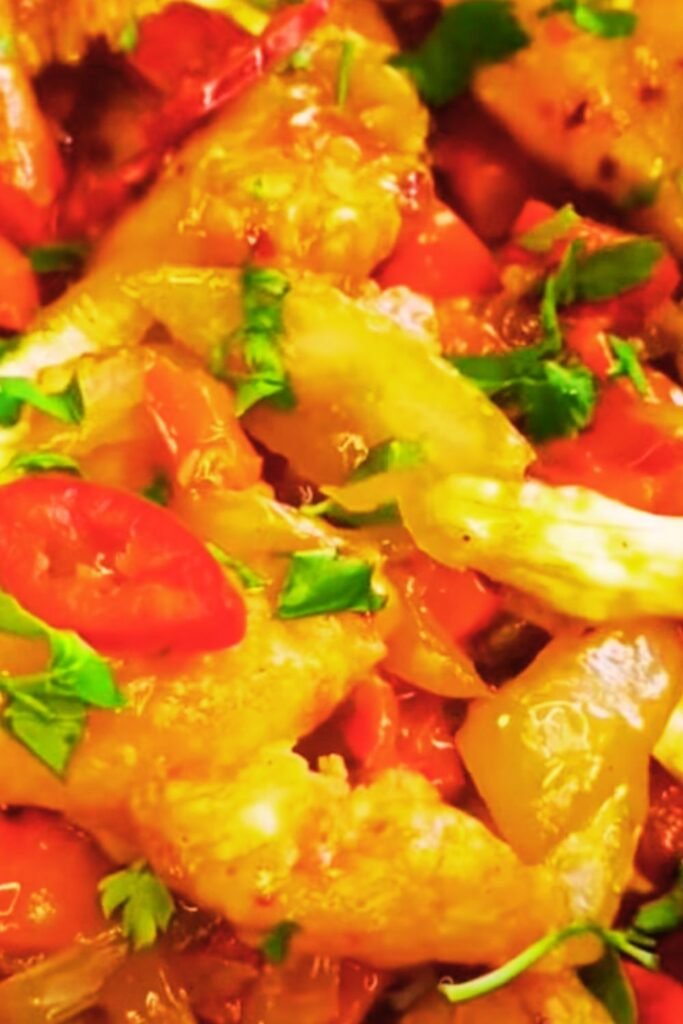Have you ever had one of those moments when a simple dish completely blows your mind? That’s exactly what happened to me the first time I tried authentic salt and pepper chicken. This humble dish, with its perfect balance of flavors and textures, has become my go-to comfort food and a staple when I’m entertaining guests.
When done right, salt and pepper chicken delivers an incredible combination of crispy, juicy chicken pieces seasoned with aromatic spices that dance on your tongue with every bite. It’s no wonder this dish has gained immense popularity worldwide, transcending its Chinese origins to become a beloved favorite in many homes and restaurants.
In this comprehensive guide, I’ll share everything I’ve learned about making restaurant-quality salt and pepper chicken at home. From the history behind this iconic dish to my tried-and-tested recipe with all the tips and tricks I’ve picked up along the way, you’ll be well-equipped to create this mouthwatering delicacy in your own kitchen.
The Origins of Salt and Pepper Chicken
Salt and pepper chicken, known as “椒盐鸡” (jiāo yán jī) in Mandarin, originated in the Cantonese cuisine of southern China. While it may seem like a simple combination of ingredients, this dish represents the essence of Chinese cooking philosophy: achieving harmony through contrasting flavors and textures.
Traditionally, salt and pepper chicken was served as a popular street food item or as part of a larger family-style meal. The dish showcases the Chinese culinary technique of “dry-frying” (gan bian), where ingredients are quickly cooked in hot oil to achieve a crispy exterior while maintaining tender juiciness inside.
What makes this dish special is its beautiful simplicity. The primary flavors come from just salt and pepper – but not just any salt and pepper. The authentic version uses a specific salt and pepper mixture that includes Sichuan peppercorns, which create that distinctive numbing sensation on your tongue.
Over time, this dish has evolved and been adapted across different regions and cultures. In the West, it’s become a staple in Chinese takeout menus, often featuring larger chicken pieces compared to the smaller, bone-in portions traditionally served in China.
Essential Ingredients for Perfect Salt and Pepper Chicken
The beauty of salt and pepper chicken lies in its simplicity, but each ingredient plays a crucial role in creating that perfect flavor profile. Here’s what you’ll need to make authentic salt and pepper chicken:
The Main Components
- Chicken: I recommend using boneless chicken thighs for the perfect balance of flavor and juiciness. They stay tender even after frying, unlike chicken breast which can dry out. If you prefer white meat, chicken breast will work too, but be careful not to overcook it.
- The Salt and Pepper Mixture: This is where the magic happens! Traditional salt and pepper chicken uses a special mixture that includes:
- White pepper (finely ground)
- Sichuan peppercorns (toasted and ground)
- Sea salt or kosher salt (never iodized table salt)
- Aromatics: These ingredients create the fragrant base that makes this dish so irresistible:
- Garlic (finely minced)
- Green and red chili peppers (finely diced)
- Spring onions/scallions (chopped)
- Ginger (finely minced)
- Coating: For that perfect crispy exterior:
- Cornstarch (primary coating)
- A touch of baking powder (helps achieve extra crispiness)
- Five-spice powder (optional but adds wonderful depth)
Ingredient Quality Matters
I’ve found that using high-quality ingredients makes a significant difference in the final result. Here’s what I recommend:
- Chicken: If possible, source free-range or organic chicken. The flavor difference is noticeable.
- Peppercorns: Freshly ground pepper has a much more vibrant flavor than pre-ground options. For Sichuan peppercorns, look for ones that are bright red in color with no black seeds inside.
- Oil: Use a neutral oil with a high smoke point such as peanut, vegetable, or canola oil for frying.

My Foolproof Salt and Pepper Chicken Recipe
After many attempts (and some delicious failures), I’ve perfected my salt and pepper chicken recipe. This version stays true to the authentic flavors while being accessible for home cooks.
Ingredients (Serves 4)
For the chicken:
- 1½ pounds (680g) boneless, skinless chicken thighs, cut into 1-inch pieces
- 2 tablespoons Shaoxing wine (or dry sherry as a substitute)
- 1 tablespoon soy sauce
- 1 teaspoon sesame oil
- ½ teaspoon white pepper
- ¼ teaspoon salt
For the coating:
- ¾ cup cornstarch
- ¼ cup all-purpose flour
- 1 teaspoon baking powder
- ½ teaspoon five-spice powder (optional)
- ½ teaspoon salt
For the salt and pepper mixture:
- 1 tablespoon white pepper
- 1 teaspoon ground Sichuan peppercorns
- 1 tablespoon sea salt
For the aromatics:
- 6 cloves garlic, minced
- 2-inch piece ginger, minced
- 4-5 spring onions, white and green parts separated and chopped
- 2-3 fresh chili peppers (red and green), finely diced
- 1 tablespoon vegetable oil
For frying:
- Vegetable or peanut oil (enough for deep frying, approximately 3-4 cups)
Step-by-Step Instructions
Preparation Phase
- Marinate the chicken: In a large bowl, combine the chicken pieces with Shaoxing wine, soy sauce, sesame oil, white pepper, and salt. Mix well to ensure even coating. Let marinate for at least 30 minutes (or up to 2 hours in the refrigerator for deeper flavor penetration).
- Prepare the salt and pepper mixture: In a dry pan over medium heat, toast the white pepper and Sichuan peppercorns until fragrant (about 1-2 minutes), being careful not to burn them. Remove from heat, let cool, then grind to a powder if not already ground. Mix with the sea salt and set aside.
- Make the coating: In a separate bowl, combine cornstarch, flour, baking powder, five-spice powder (if using), and salt. Mix well.
Cooking Phase
- Heat the oil: In a large, deep pan or wok, heat oil to 350°F (175°C). Test the temperature by dropping in a small piece of bread – it should sizzle immediately and turn golden brown within 15 seconds.
- Coat the chicken: Take the marinated chicken and dredge each piece thoroughly in the cornstarch mixture, shaking off any excess.
- Fry the chicken: Working in batches to avoid overcrowding, carefully lower the coated chicken pieces into the hot oil. Fry for 3-4 minutes until golden brown and crispy. Use a slotted spoon to transfer the fried chicken to a wire rack or paper towel-lined plate to drain excess oil.
- Optional double-fry: For extra crispiness, allow the chicken to rest for 5 minutes, then return to the hot oil for another 1-2 minutes.
- Prepare the aromatics: In a separate wok or large pan, heat 1 tablespoon of oil over medium-high heat. Add the minced garlic, ginger, chili peppers, and white parts of spring onions. Stir-fry for 30 seconds until fragrant.
- Combine everything: Add the fried chicken to the aromatics and toss quickly to combine. Sprinkle 2-3 teaspoons of the salt and pepper mixture (adjust according to taste) over the chicken while tossing.
- Final touch: Turn off the heat and add the green parts of spring onions. Toss everything together for a few more seconds.
- Serve immediately: Transfer to a serving plate and enjoy while still hot and crispy!
Cooking Tips for Perfect Results
Through trial and error, I’ve discovered several tricks that elevate this dish from good to great:
- Double-frying technique: This is the secret to achieving that restaurant-quality crispiness that stays crispy even after tossing with the aromatics.
- Don’t overcrowd the pan: Fry in smaller batches to maintain the oil temperature and ensure even cooking.
- Temperature control: Keep the oil between 350-375°F (175-190°C) for optimal results. Too cool, and your chicken will be greasy; too hot, and it will burn before cooking through.
- Timing is crucial: The aromatics should be flash-fried just until fragrant. Overcooking will result in bitter garlic and burned spices.
- Salt and pepper balance: The traditional ratio is roughly 1:1 for salt and white pepper, but I often use slightly more pepper than salt for a more pronounced flavor.
Variations to Try
One of the joys of cooking is making a recipe your own. Here are some delicious variations to the classic salt and pepper chicken:
Regional Variations
- Hong Kong style: Includes curry powder in the coating for an additional layer of flavor.
- Taiwanese version: Often includes basil leaves tossed in at the final stage.
- Malaysian adaptation: Incorporates curry leaves and additional spices like turmeric.
Dietary Adaptations
- Gluten-free: Use only cornstarch for coating and tamari instead of soy sauce.
- Lower-carb option: Replace the cornstarch coating with almond flour and a touch of coconut flour.
Flavor Enhancements
- Citrus zest: Add lemon or lime zest to the salt and pepper mixture for a bright, citrusy note.
- Herb infusion: Fresh cilantro or Thai basil tossed in at the end adds a wonderful freshness.
- Sweet and spicy: Add a touch of honey or brown sugar to the marinade for a sweet contrast to the peppery heat.

Serving Suggestions
Salt and pepper chicken is versatile and pairs well with many side dishes. Here are my favorite ways to serve it:
Traditional Pairings
- Plain steamed rice: The perfect canvas to soak up all the flavors of the chicken.
- Stir-fried vegetables: A simple mix of bell peppers, snap peas, and carrots provides a colorful and nutritious contrast.
- Chinese soup: A light broth-based soup balances the richness of the fried chicken.
Contemporary Twists
- Salt and pepper chicken tacos: Wrap the chicken in warm tortillas with fresh slaw and avocado.
- Asian-inspired salad: Serve over mixed greens with a sesame-ginger dressing.
- Loaded fries: Top french fries with salt and pepper chicken pieces, spring onions, and a drizzle of sriracha mayo.
Beverage Pairings
- Jasmine tea: The floral notes contrast beautifully with the spicy, savory chicken.
- Lemonade: The acidity cuts through the richness of the fried chicken.
- Sparkling water with cucumber: A refreshing palate cleanser between bites.
Troubleshooting Common Issues
Even experienced cooks sometimes encounter challenges. Here’s how to overcome the most common issues when making salt and pepper chicken:
| Problem | Possible Cause | Solution |
|---|---|---|
| Chicken isn’t crispy | Oil temperature too low | Use a thermometer to maintain 350-375°F (175-190°C) |
| Coating falls off | Chicken too wet before coating | Pat chicken completely dry before coating |
| Chicken is greasy | Oil temperature dropped too low | Fry in smaller batches to maintain oil temperature |
| Too salty | Overseasoning after cooking | Add salt gradually and taste as you go |
| Burnt aromatics | Heat too high or cooked too long | Use medium heat and stir-fry aromatics for just 30 seconds |
| Chicken tough or dry | Overcooked chicken or using breast meat | Use chicken thighs and don’t overcook |
| Bland flavor | Insufficient marinating time | Marinate for at least 30 minutes or longer |
| Soggy after sitting | Steam from hot chicken | Serve immediately and on a pre-warmed plate |
How to Store and Reheat Leftovers
While salt and pepper chicken is definitely best enjoyed fresh, sometimes you’ll have leftovers. Here’s how to make the most of them:
Storage
- Refrigeration: Store in an airtight container in the refrigerator for up to 2 days. Keep the chicken separate from any unused sauce or garnishes.
- Freezing: Not recommended as the texture significantly deteriorates upon thawing.
Reheating
- Oven method (best for maintaining crispiness): Preheat oven to 350°F (175°C). Place chicken pieces on a baking sheet and heat for 8-10 minutes until hot and crisp.
- Air fryer: 3-4 minutes at 375°F (190°C) works wonders for restoring crispiness.
- Avoid microwave: This will make the chicken soggy and chewy.
Health and Nutrition Information
Let’s be honest – salt and pepper chicken isn’t a health food, but understanding its nutritional profile can help you include it in a balanced diet:
| Nutrient | Amount per Serving | % Daily Value* |
|---|---|---|
| Calories | Approximately 420 | – |
| Protein | 28g | 56% |
| Total Fat | 24g | 31% |
| Saturated Fat | 5g | 25% |
| Carbohydrates | 18g | 7% |
| Dietary Fiber | 1g | 4% |
| Sodium | 860mg | 37% |
| Potassium | 320mg | 7% |
| Iron | 2mg | 11% |
*Based on a 2,000 calorie diet
Healthier Adaptations
If you’re watching your calories or fat intake, consider these modifications:
- Air fryer method: Use an air fryer instead of deep-frying to reduce oil usage by up to 80%.
- Baked version: Coat the chicken as directed, then bake at 425°F (220°C) for 20-25 minutes, turning halfway through.
- Portion control: Serve with extra vegetables and a smaller portion of chicken.
The Cultural Significance of Salt and Pepper Dishes
In Chinese cuisine, salt and pepper dishes represent more than just a flavor profile – they embody the philosophy of balance that underpins traditional Chinese cooking and medicine.
Symbolic Meaning
- Salt: Represents the earth element and is associated with preservation and purification.
- Pepper: Connected to fire and warmth, believed to dispel cold from the body according to traditional Chinese medicine.
Together, these ingredients create a harmonious balance of flavors that stimulate different taste receptors – epitomizing the yin-yang concept central to Chinese culture.
Modern Popularity
Salt and pepper chicken has found its way into global food culture, appearing on menus from high-end restaurants to street food stalls. Its popularity stems from its accessible flavor profile that appeals to many palates while still offering an authentic taste of Chinese cuisine.

Q&A Section: Your Salt and Pepper Chicken Questions Answered
Q: Can I use chicken wings instead of chicken thighs for this recipe? Absolutely! Chicken wings work beautifully for salt and pepper chicken. I recommend separating them into drumettes and flats for more even cooking. You’ll need to adjust the frying time – wings typically need about 8-10 minutes total frying time to cook through properly.
Q: Is there a substitute for Sichuan peppercorns if I can’t find them? While Sichuan peppercorns provide that distinctive numbing sensation that’s hard to replicate, you can substitute with a mixture of black pepper and a pinch of ground coriander. Another option is to use grains of paradise or even a tiny pinch of ground cloves mixed with black pepper. The flavor profile will be different but still delicious.
Q: My coating always falls off during frying. What am I doing wrong? This is a common issue! Make sure your chicken is completely dry before coating – pat it with paper towels after marinating. Also, let the coated chicken rest for 5-10 minutes before frying to allow the coating to adhere better. Finally, avoid turning the chicken too frequently while frying – let it develop a crust on one side before flipping.
Q: How spicy is authentic salt and pepper chicken? Traditional salt and pepper chicken has a moderate heat level that comes from both the white pepper and fresh chili peppers. However, you can easily adjust the spice level to your preference by changing the amount of chili peppers or removing the seeds for a milder version.
Q: Can I make this dish ahead of time for a party? While it’s best served immediately after cooking, you can prepare components ahead of time. Marinate the chicken and prepare the coating mixture up to a day in advance. You can even fry the chicken a few hours before serving, then reheat in a 350°F (175°C) oven for 8-10 minutes just before tossing with the freshly prepared aromatics.
Q: What’s the difference between salt and pepper chicken and salt and chili chicken? Salt and pepper chicken focuses on the balanced flavor of salt and pepper (particularly white pepper and Sichuan peppercorns) with aromatics. Salt and chili chicken places more emphasis on chili heat, often incorporating chili powder or flakes into the coating itself. Both are delicious but offer slightly different flavor profiles.
Conclusion
Salt and pepper chicken may seem simple at first glance, but its perfect balance of flavors and textures makes it a truly remarkable dish. From its humble origins in Cantonese cuisine to its current global popularity, this dish demonstrates how masterful simplicity can create something extraordinary.
I hope this comprehensive guide has equipped you with everything you need to create restaurant-quality salt and pepper chicken in your own kitchen. Remember, cooking is both an art and a science – don’t be afraid to experiment and adapt the recipe to your own taste preferences.
The joy of this dish lies not just in its delicious flavor but in the process of creating it. There’s something deeply satisfying about achieving that perfect crispiness and aromatic finish. So gather your ingredients, heat up your wok, and prepare to impress yourself and your loved ones with this iconic dish.
Happy cooking!